A Numerical Study for Tropical Cyclone Atsani (2020) Past Offshore of Southern Taiwan under Topographic Influences
Abstract
1. Introduction
2. The Model and Experimental Configurations
2.1. MPAS Model
2.2. Vortex Initialization
2.3. Atsani and Numerical Experiments
3. Simulation Results
3.1. Track and Intensity Simulations
3.2. Rainfall Simulations
3.3. Cyclone Circulation
3.4. Potential Vorticity (PV) Tendency Budget for Track Deflection
3.5. Results of Idealized Experiments
4. Conclusions
Author Contributions
Funding
Institutional Review Board Statement
Informed Consent Statement
Data Availability Statement
Acknowledgments
Conflicts of Interest
References
- Wu, C.-C.; Kuo, Y.-H. Typhoons affecting Taiwan: Current understanding and future challenges. Bull. Am. Meteorol. Soc. 1999, 80, 67–80. [Google Scholar] [CrossRef]
- Kim, H.-J.; Suh, S.-W. Improved hypothetical typhoon generation technique for storm surge frequency analyses on the Southwest Korean Coast. J. Coast. Res. 2018, 85, 516–520. [Google Scholar] [CrossRef]
- Hsu, L.-H.; Kuo, H.-C.; Fovell, R.G. On the geographic asymmetry of typhoon translation speed across the mountainous island of Taiwan. J. Atmos. Sci. 2013, 70, 1006–1022. [Google Scholar] [CrossRef]
- Wei-Jen Chang, S. The orographic effects induced by an island mountain range on propagating tropical cyclones. Mon. Weather Rev. 1982, 110, 1255–1270. [Google Scholar] [CrossRef]
- Bender, M.A.; Tuleya, R.E.; Kurihara, Y. A numerical study of the effect of island terrain on tropical cyclones. Mon. Weather Rev. 1987, 115, 130–155. [Google Scholar] [CrossRef]
- Yeh, T.-C.; Elsberry, R.L. Interaction of typhoons with the Taiwan orography. Part I: Upstream track deflections. Mon. Weather Rev. 1993, 121, 3193–3212. [Google Scholar] [CrossRef]
- Yeh, T.-C.; Elsberry, R.L. Interaction of typhoons with the Taiwan orography. Part II: Continuous and discontinuous tracks across the island. Mon. Weather Rev. 1993, 121, 3213–3233. [Google Scholar] [CrossRef][Green Version]
- Lin, Y.-L.; Han, J.; Hamilton, D.W.; Huang, C.-Y. Orographic influence on a drifting cyclone. J. Atmos. Sci. 1999, 56, 534–562. [Google Scholar] [CrossRef]
- Kuo, H.-C.; Williams, R.; Chen, J.-H.; Chen, Y.-L. Topographic effects on barotropic vortex motion: No mean flow. J. Atmos. Sci. 2001, 58, 1310–1327. [Google Scholar] [CrossRef]
- Lin, Y.-L.; Ensley, D.B.; Chiao, S.; Huang, C.-Y. Orographic influences on rainfall and track deflection associated with the passage of a tropical cyclone. Mon. Weather Rev. 2002, 130, 2929–2950. [Google Scholar] [CrossRef]
- Lin, Y.-L.; Chen, S.-Y.; Hill, C.M.; Huang, C.-Y. Control parameters for the influence of a mesoscale mountain range on cyclone track continuity and deflection. J. Atmos. Sci. 2005, 62, 1849–1866. [Google Scholar] [CrossRef]
- Huang, C.-Y.; Lin, Y.-L. The influence of mesoscale mountains on vortex tracks: Shallow-water modeling study. Meteorol. Atmos. Phys. 2008, 101, 1–20. [Google Scholar] [CrossRef]
- Jian, G.-J.; Wu, C.-C. A numerical study of the track deflection of Supertyphoon Haitang (2005) prior to its landfall in Taiwan. Mon. Weather Rev. 2008, 136, 598–615. [Google Scholar] [CrossRef]
- Lin, Y.-L.; Savage, L.C., III. Effects of landfall location and the approach angle of a cyclone vortex encountering a mesoscale mountain range. J. Atmos. Sci. 2011, 68, 2095–2106. [Google Scholar] [CrossRef]
- Huang, Y.-H.; Wu, C.-C.; Wang, Y. The influence of island topography on typhoon track deflection. Mon. Weather Rev. 2011, 139, 1708–1727. [Google Scholar] [CrossRef]
- Wu, C.-C.; Li, T.-H.; Huang, Y.-H. Influence of mesoscale topography on tropical cyclone tracks: Further examination of the channeling effect. J. Atmos. Sci. 2015, 72, 3032–3050. [Google Scholar] [CrossRef]
- Tang, C.K.; Chan, J.C. Idealized simulations of the effect of Taiwan topography on the tracks of tropical cyclones with different sizes. Q. J. R. Meteorol. Soc. 2016, 142, 793–804. [Google Scholar] [CrossRef]
- Tang, C.K.; Chan, J.C. Idealized simulations of the effect of Taiwan topography on the tracks of tropical cyclones with different steering flow strengths. Q. J. R. Meteorol. Soc. 2016, 142, 3211–3221. [Google Scholar] [CrossRef]
- Huang, C.-Y.; Chen, C.-A.; Chen, S.-H.; Nolan, D.S. On the upstream track deflection of tropical cyclones past a mountain range: Idealized experiments. J. Atmos. Sci. 2016, 73, 3157–3180. [Google Scholar] [CrossRef][Green Version]
- Hsu, L.-H.; Su, S.-H.; Fovell, R.G.; Kuo, H.-C. On typhoon track deflections near the east coast of Taiwan. Mon. Weather Rev. 2018, 146, 1495–1510. [Google Scholar] [CrossRef]
- Huang, K.-C.; Wu, C.-C. The impact of idealized terrain on upstream tropical cyclone track. J. Atmos. Sci. 2018, 75, 3887–3910. [Google Scholar] [CrossRef]
- Huang, C.-Y.; Huang, C.-H.; Skamarock, W.C. Track deflection of typhoon Nesat (2017) as realized by multiresolution simulations of a global model. Mon. Weather Rev. 2019, 147, 1593–1613. [Google Scholar] [CrossRef]
- Huang, C.-Y.; Chou, C.-W.; Chen, S.-H.; Xie, J.-H. Topographic rainfall of tropical cyclones past a mountain range as categorized by idealized simulations. Weather Forecast. 2020, 35, 25–49. [Google Scholar] [CrossRef]
- Skamarock, W.C.; Klemp, J.B.; Duda, M.G.; Fowler, L.D.; Park, S.-H.; Ringler, T.D. A multiscale nonhydrostatic atmospheric model using centroidal Voronoi tesselations and C-grid staggering. Mon. Weather Rev. 2012, 140, 3090–3105. [Google Scholar] [CrossRef]
- Chen, S.-Y.; Shih, C.-P.; Huang, C.-Y.; Teng, W.-H. An Impact Study of GNSS RO Data on the Prediction of Typhoon Nepartak (2016) Using a Multiresolution Global Model with 3D-Hybrid Data Assimilation. Weather Forecast. 2021, 36, 957–977. [Google Scholar]
- Huang, C.-Y.; Lin, J.-Y.; Skamarock, W.C.; Chen, S.-Y. Typhoon forecasts with dynamic vortex initialization using an unstructured mesh global model. Mon. Wea. Rev. 2022; submitted. [Google Scholar]
- Van Nguyen, H.; Chen, Y.-L. High-resolution initialization and simulations of Typhoon Morakot (2009). Mon. Weather Rev. 2011, 139, 1463–1491. [Google Scholar] [CrossRef]
- Cha, D.-H.; Wang, Y. A dynamical initialization scheme for real-time forecasts of tropical cyclones using the WRF model. Mon. Weather Rev. 2013, 141, 964–986. [Google Scholar] [CrossRef]
- Van Nguyen, H.; Chen, Y.-L. Improvements to a tropical cyclone initialization scheme and impacts on forecasts. Mon. Weather Rev. 2014, 142, 4340–4356. [Google Scholar] [CrossRef]
- Liu, H.-Y.; Wang, Y.; Xu, J.; Duan, Y. A dynamical initialization scheme for tropical cyclones under the influence of terrain. Weather Forecast. 2018, 33, 641–659. [Google Scholar] [CrossRef]
- Hsiao, L.-F.; Liou, C.-S.; Yeh, T.-C.; Guo, Y.-R.; Chen, D.-S.; Huang, K.-N.; Terng, C.-T.; Chen, J.-H. A vortex relocation scheme for tropical cyclone initialization in advanced research WRF. Mon. Weather Rev. 2010, 138, 3298–3315. [Google Scholar] [CrossRef]
- Hsiao, L.-F.; Chen, D.-S.; Hong, J.-S.; Yeh, T.-C.; Fong, C.-T. Improvement of the Numerical Tropical Cyclone Prediction System at the Central Weather Bureau of Taiwan: TWRF (Typhoon WRF). Atmosphere 2020, 11, 657. [Google Scholar] [CrossRef]
- Grell, G.A.; Freitas, S.R. A scale and aerosol aware stochastic convective parameterization for weather and air quality modeling. Atmos. Chem. Phys. 2014, 14, 5233–5250. [Google Scholar] [CrossRef]
- Zhang, C.; Wang, Y. Projected future changes of tropical cyclone activity over the western North and South Pacific in a 20-km-mesh regional climate model. J. Clim. 2017, 30, 5923–5941. [Google Scholar] [CrossRef]
- Thompson, G.; Field, P.R.; Rasmussen, R.M.; Hall, W.D. Explicit forecasts of winter precipitation using an improved bulk microphysics scheme. Part II: Implementation of a new snow parameterization. Mon. Weather Rev. 2008, 136, 5095–5115. [Google Scholar] [CrossRef]
- Niu, G.Y.; Yang, Z.L.; Mitchell, K.E.; Chen, F.; Ek, M.B.; Barlage, M.; Kumar, A.; Manning, K.; Niyogi, D.; Rosero, E. The community Noah land surface model with multiparameterization options (Noah-MP): 1. Model description and evaluation with local-scale measurements. J. Geophys. Res. Atmos. 2011, 116, D12. [Google Scholar] [CrossRef]
- Nakanishi, M.; Niino, H. Development of an improved turbulence closure model for the atmospheric boundary layer. J. Meteorol. Soc. Japan Ser. II 2009, 87, 895–912. [Google Scholar] [CrossRef]
- Hong, S.-Y.; Noh, Y.; Dudhia, J. A new vertical diffusion package with an explicit treatment of entrainment processes. Mon. Weather Rev. 2006, 134, 2318–2341. [Google Scholar] [CrossRef]
- Iacono, M.J.; Delamere, J.S.; Mlawer, E.J.; Shephard, M.W.; Clough, S.A.; Collins, W.D. Radiative forcing by long-lived greenhouse gases: Calculations with the AER radiative transfer models. J. Geophys. Res. Atmos. 2008, 113. [Google Scholar] [CrossRef]
- Xu, K.-M.; Randall, D.A. A semiempirical cloudiness parameterization for use in climate models. J. Atmos. Sci. 1996, 53, 3084–3102. [Google Scholar] [CrossRef]
- Hong, S.-Y.; Lim, J.-O.J. The WRF single-moment 6-class microphysics scheme (WSM6). Asia-Pac. J. Atmos. Sci. 2006, 42, 129–151. [Google Scholar]
- Wu, L.; Wang, B. A potential vorticity tendency diagnostic approach for tropical cyclone motion. Mon. Weather Rev. 2000, 128, 1899–1911. [Google Scholar] [CrossRef]
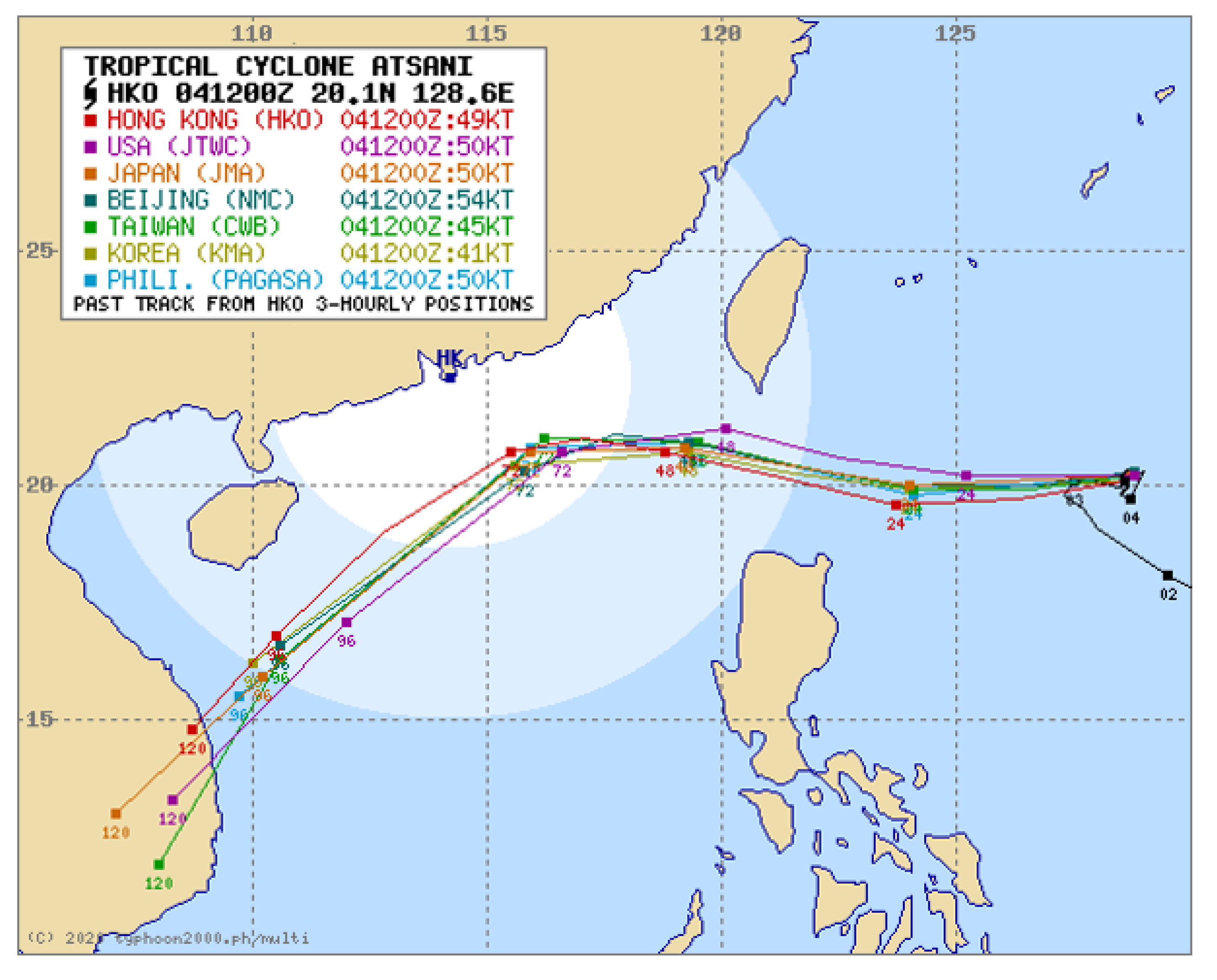


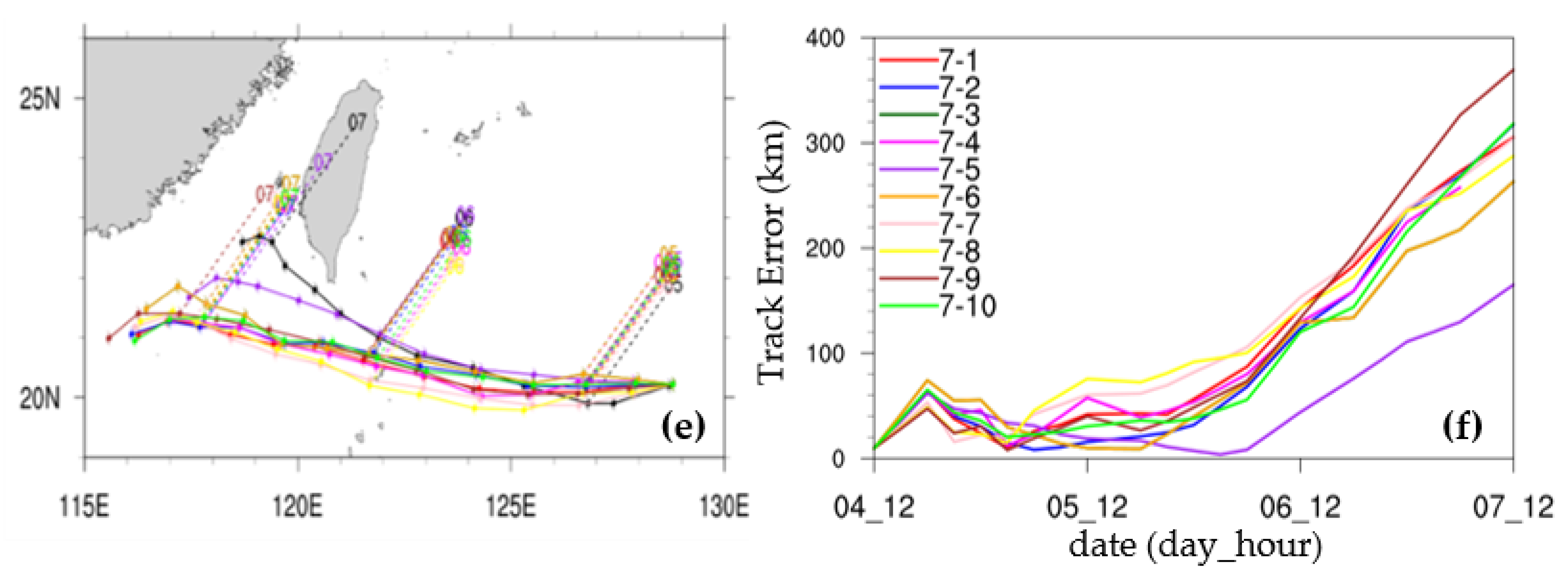

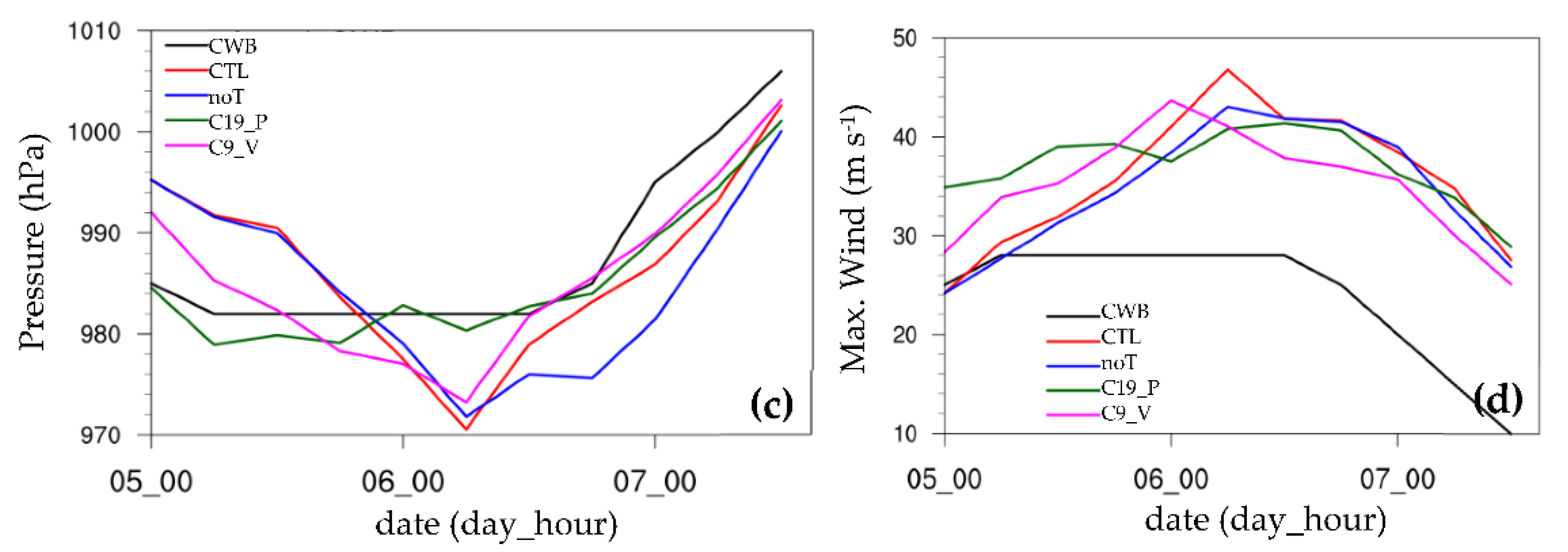
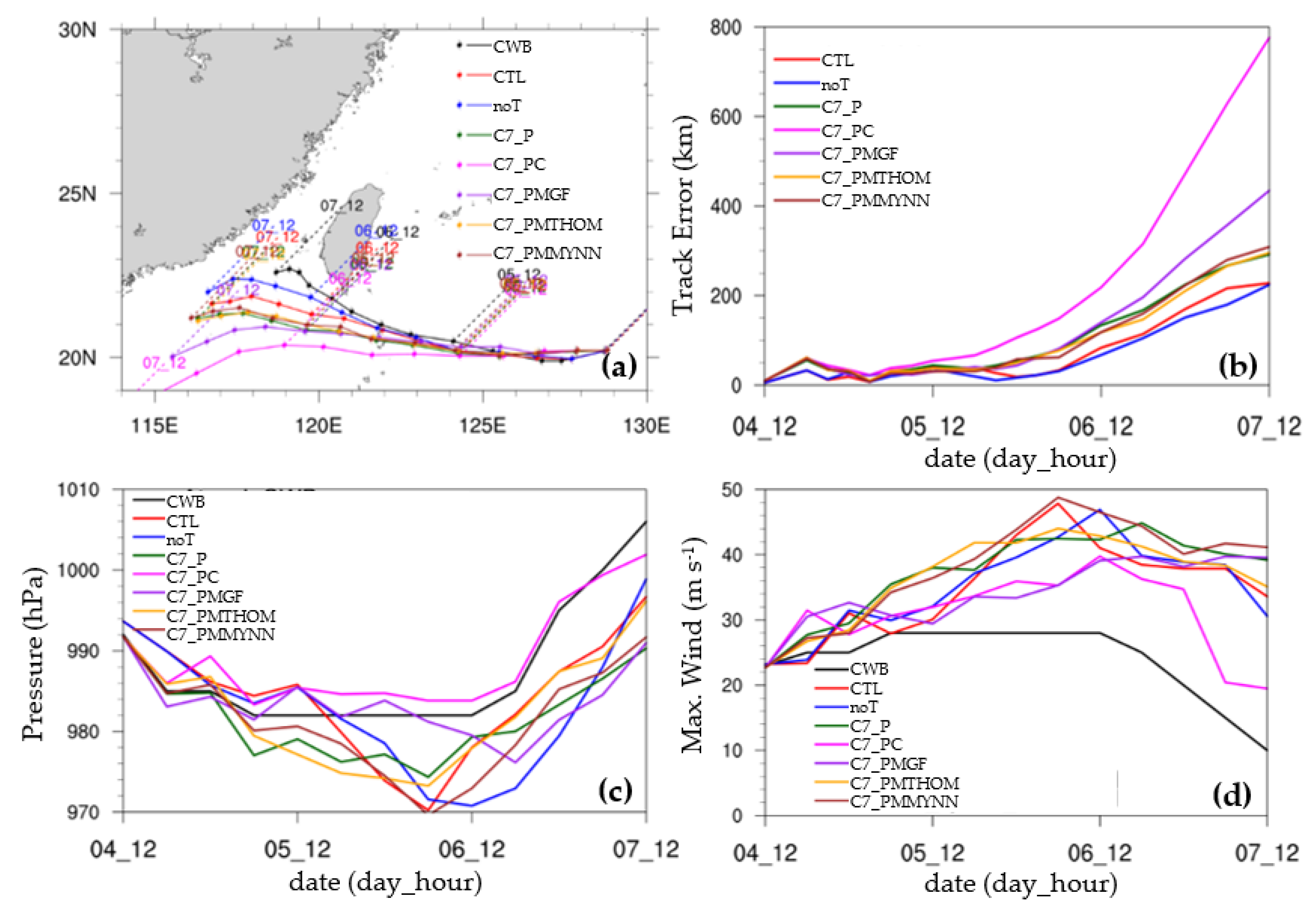




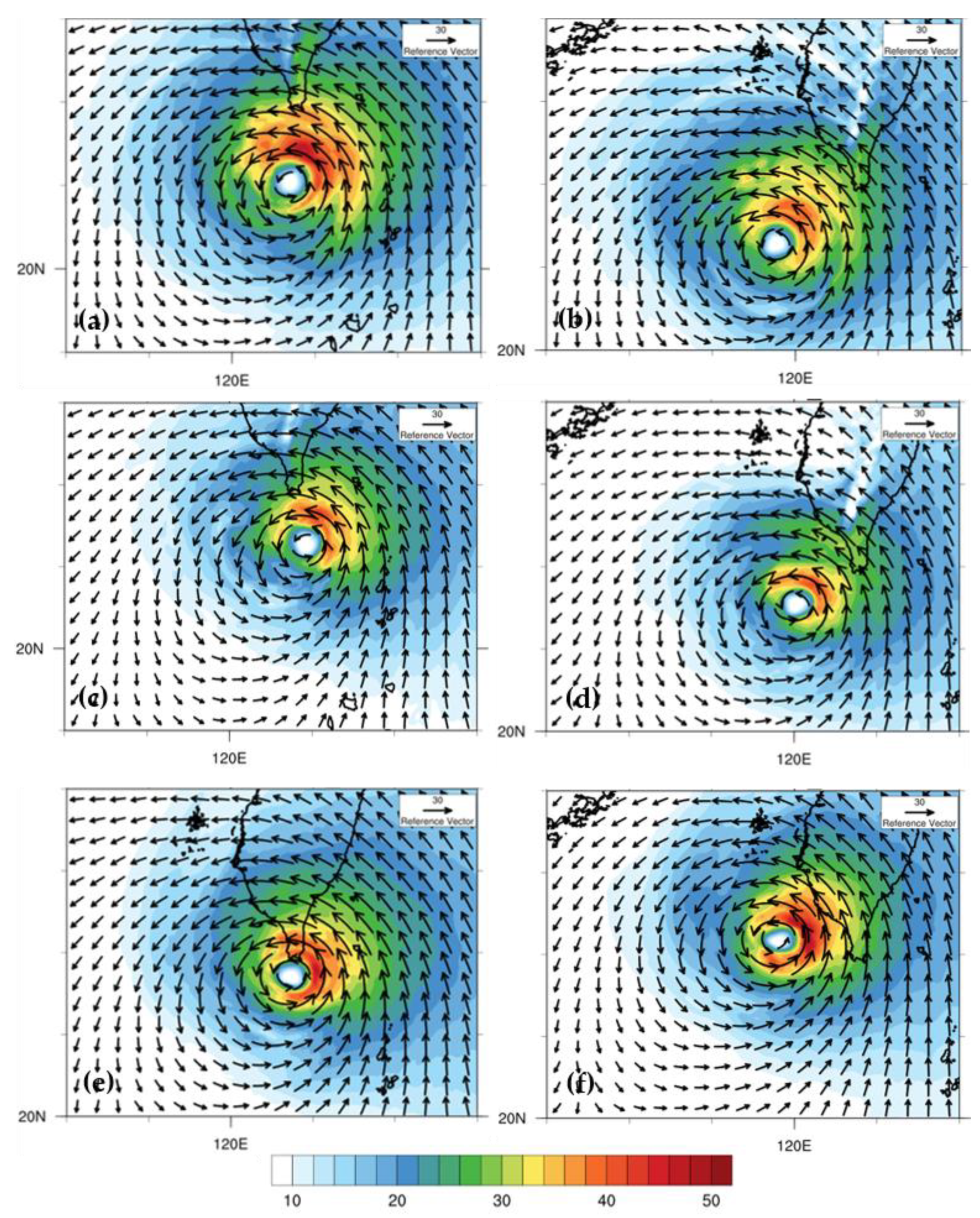

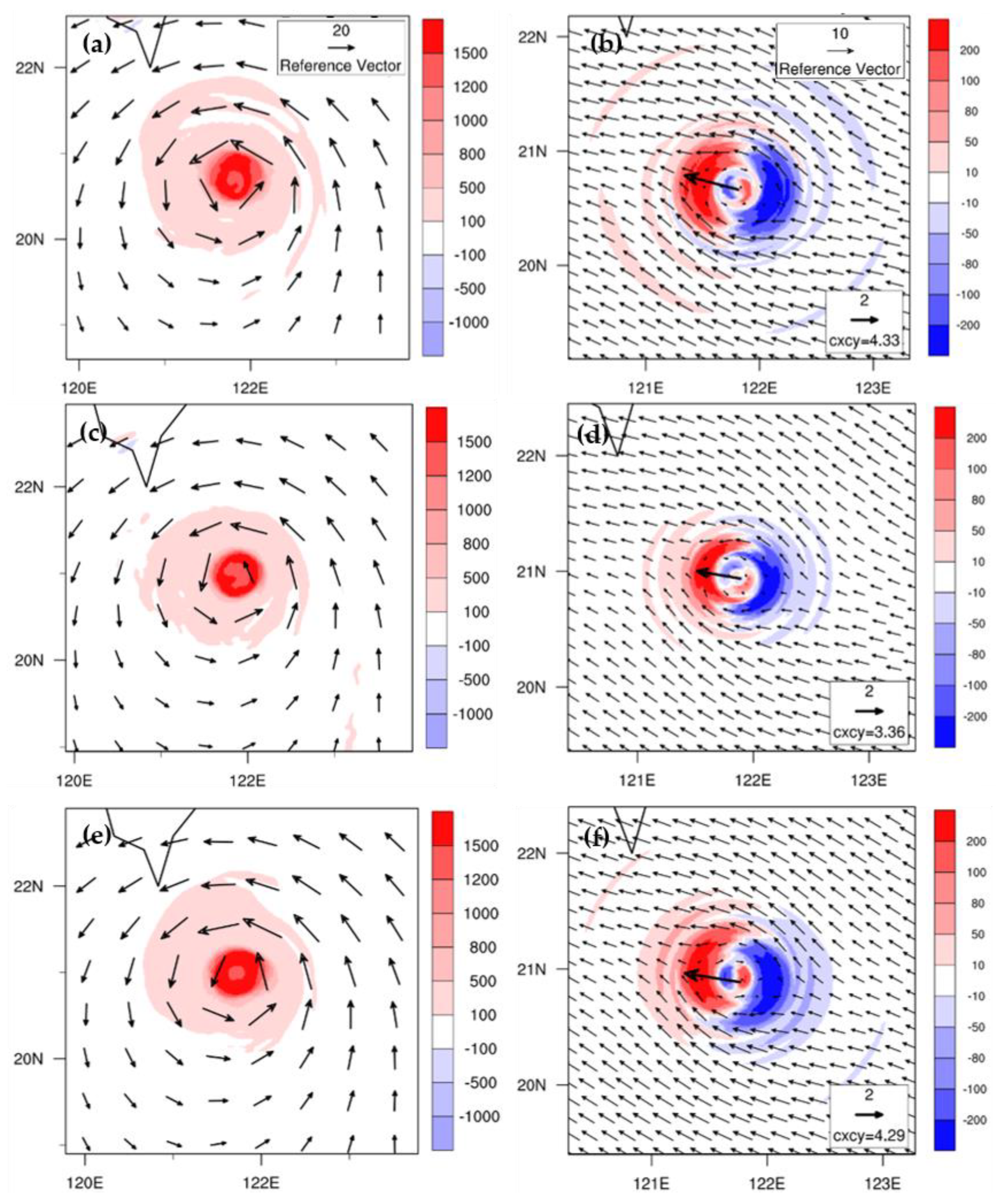


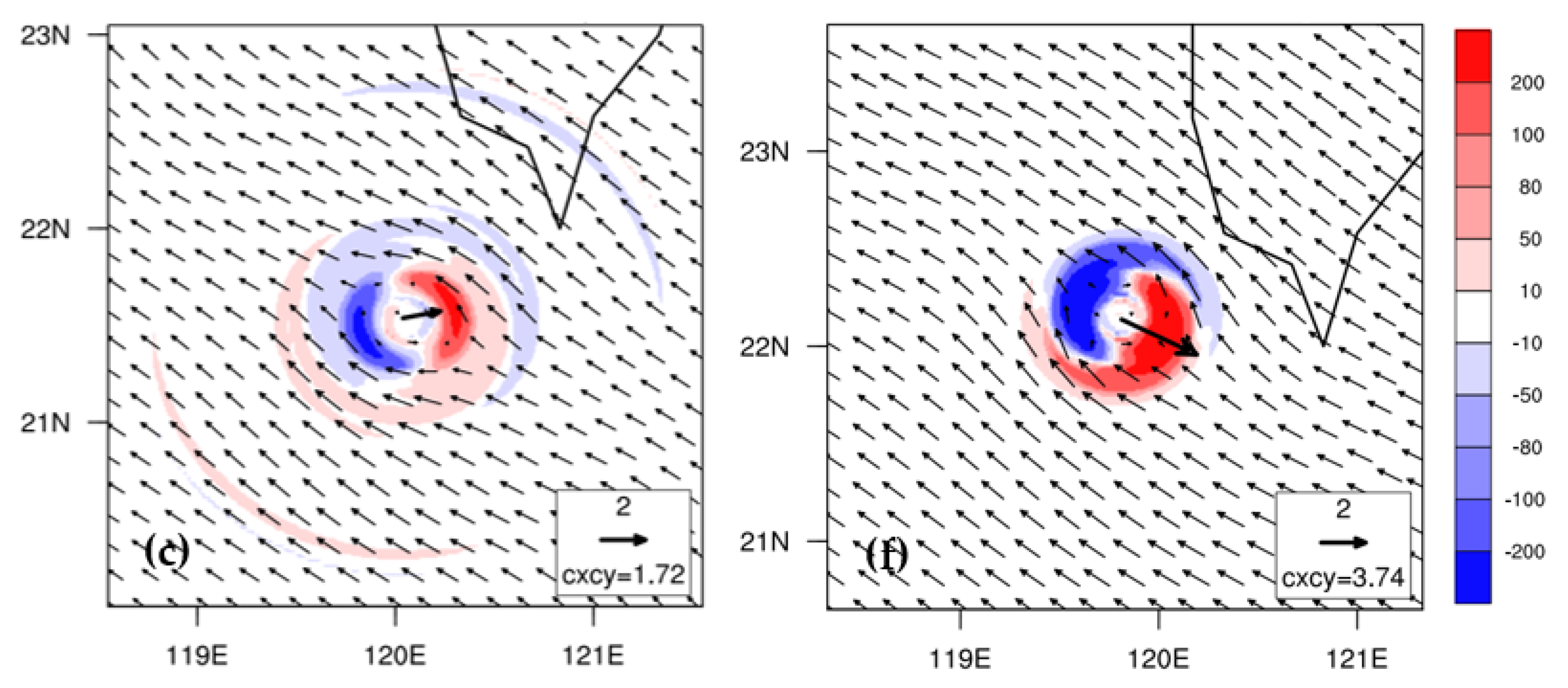

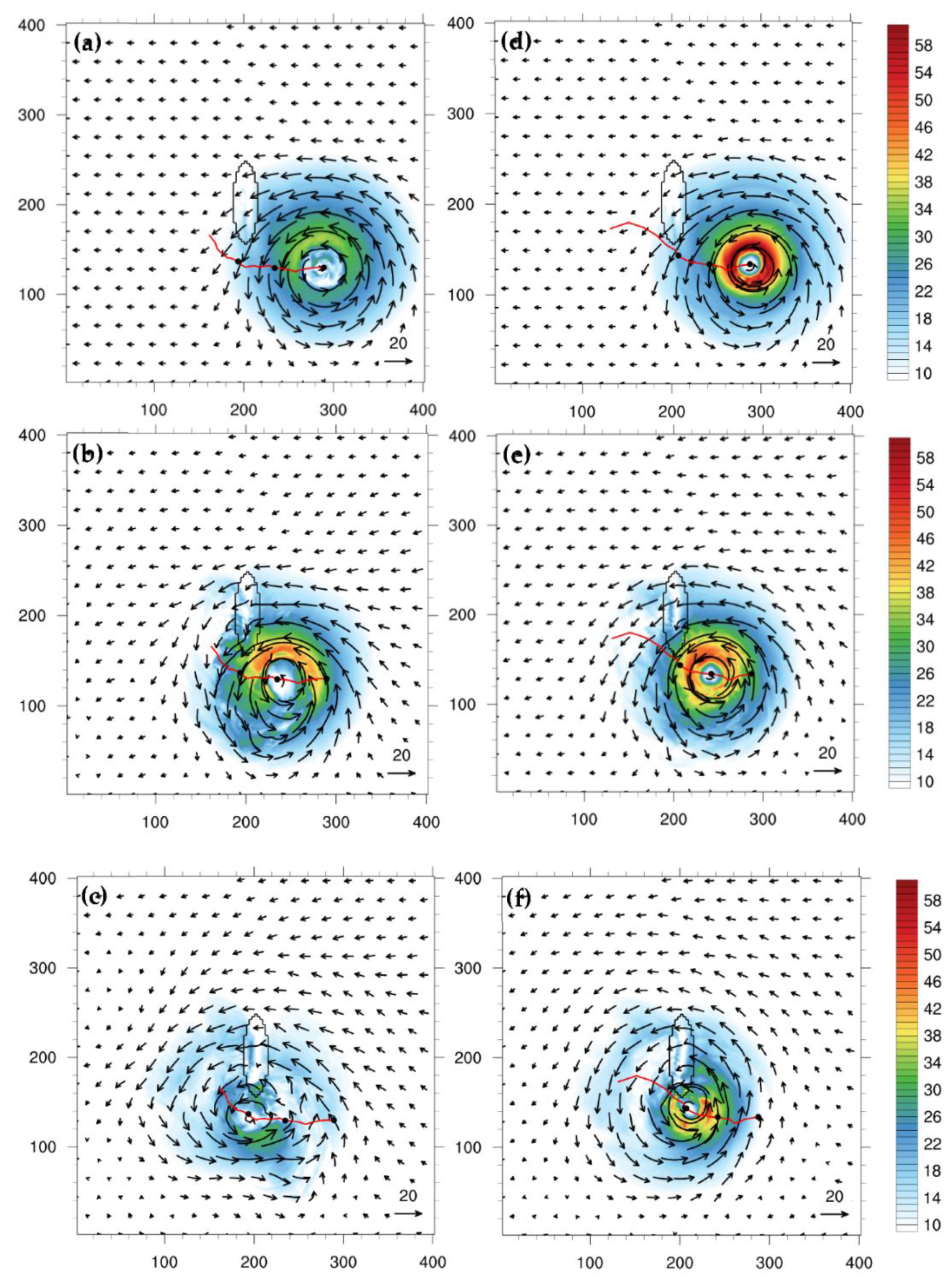
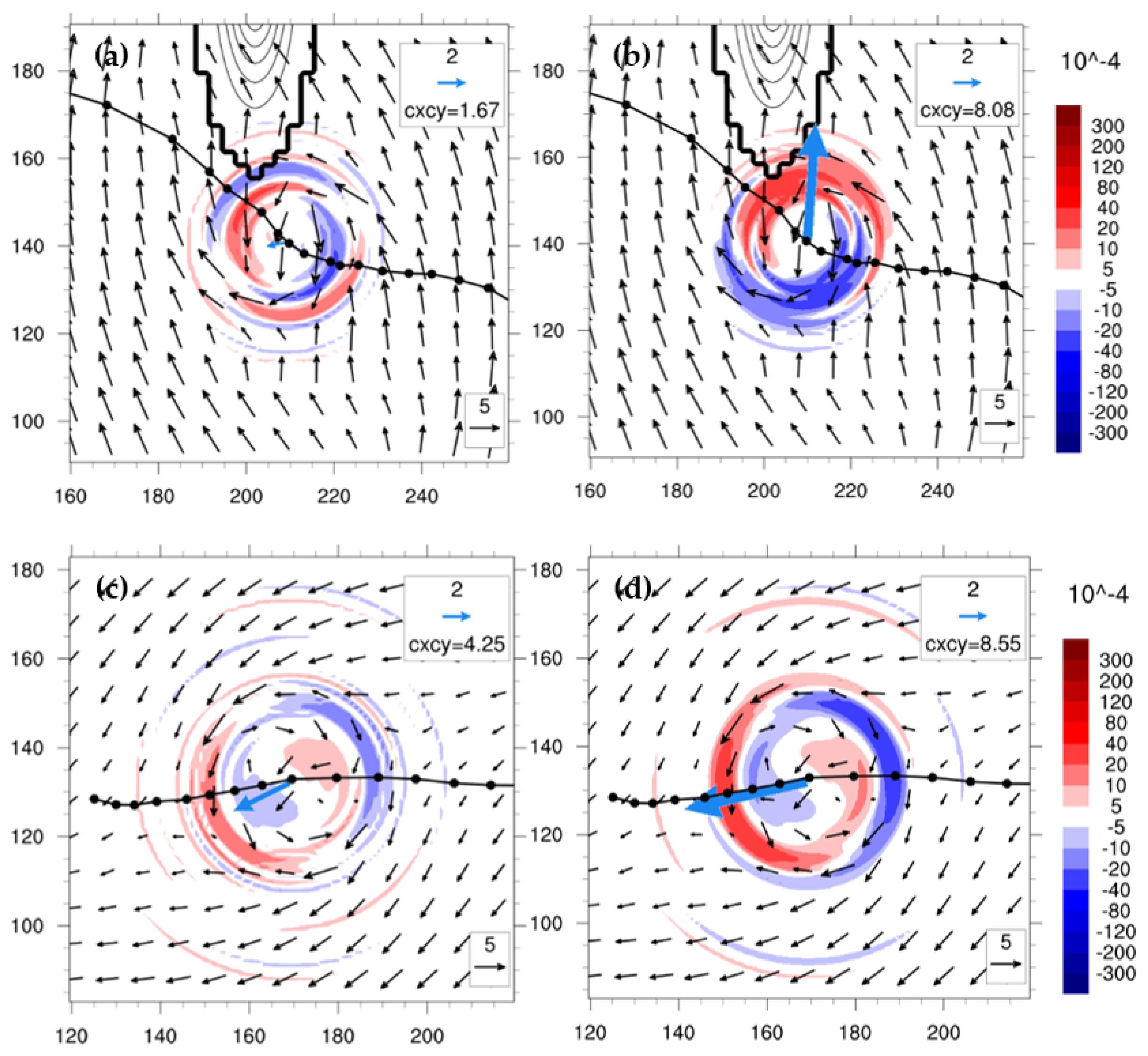
| Experiment Names | Physics Schemes | DVI | Resetting Taiwan Terrain |
|---|---|---|---|
| CTL | M-suite | No | No |
| noT | M-suite | No | Yes |
| C7_P | M-suite | P-match | No |
| C7-5_P | M-suite | Fifth member with P-match | No |
| C7-5_P_noT | M-suite | Fifth member with P-match | Yes |
| C7_PC | C-suite | P-match | No |
| C7_PMGF | M-suite, but using Grell-Freitas scheme | P-match | No |
| C7_PMTHOM | M-suite, but using Thompson scheme | P-match | No |
| C7_PMMTNN | M-suite, but using MYNN scheme | P-match | No |
| Physical Parameterization | Mesoscale Reference Suite | Convection-Permitting Suite |
|---|---|---|
| Cumulus convection | New-Tiedtke | Grell–Freitas |
| Cloud microphysics | WSM6 | Thompson |
| Land surface | Noah | Noah |
| Boundary layer | YSU | MYNN |
| Surface layer | Monin–Obukhovi | MYNN |
| Radiation LW/SW | RRTMG | RRTMG |
| Cloud fraction for radiation | Xu–Randall | Xu–Randall |
| Acronyms of he physics schemes: | ||
| Grell-Freitas | Grell–Freitas convective cumulus parameterization ([33]) | |
| New-Tiedtke | New-Tiedtke convective cumulus parameterization ([34]) | |
| Thompson | Cloud microphysics scheme with prognostic ice, snow, graupel processes and rain number concentration ([35]) | |
| Noah | Noah land surface model ([36]) | |
| MYNN | Mellor–Yamada Nakanishi and Niino Level-3 PBL parameterization ([37]) | |
| YSU | Yonsei University (YSU) planetary boundary-layer parameterization ([38]) | |
| RRTMG | Rapid Radiative Transfer Model for General Circulation Models (RRTMG) longwave (LW) and shortwave (SW) scheme ([39]) | |
| Xu-Randall | Xu–Randall cloud fraction parameterization ([40]) | |
| WSM6 | Single-moment 6-class microphysics scheme of the WRF Model ([41]) | |
Publisher’s Note: MDPI stays neutral with regard to jurisdictional claims in published maps and institutional affiliations. |
© 2022 by the authors. Licensee MDPI, Basel, Switzerland. This article is an open access article distributed under the terms and conditions of the Creative Commons Attribution (CC BY) license (https://creativecommons.org/licenses/by/4.0/).
Share and Cite
Huang, C.-Y.; Lin, J.-Y.; Kuo, H.-C.; Chen, D.-S.; Hong, J.-S.; Hsiao, L.-F.; Chen, S.-Y. A Numerical Study for Tropical Cyclone Atsani (2020) Past Offshore of Southern Taiwan under Topographic Influences. Atmosphere 2022, 13, 618. https://doi.org/10.3390/atmos13040618
Huang C-Y, Lin J-Y, Kuo H-C, Chen D-S, Hong J-S, Hsiao L-F, Chen S-Y. A Numerical Study for Tropical Cyclone Atsani (2020) Past Offshore of Southern Taiwan under Topographic Influences. Atmosphere. 2022; 13(4):618. https://doi.org/10.3390/atmos13040618
Chicago/Turabian StyleHuang, Ching-Yuang, Jia-Yang Lin, Hung-Chi Kuo, Der-Song Chen, Jing-Shan Hong, Ling-Feng Hsiao, and Shu-Ya Chen. 2022. "A Numerical Study for Tropical Cyclone Atsani (2020) Past Offshore of Southern Taiwan under Topographic Influences" Atmosphere 13, no. 4: 618. https://doi.org/10.3390/atmos13040618
APA StyleHuang, C.-Y., Lin, J.-Y., Kuo, H.-C., Chen, D.-S., Hong, J.-S., Hsiao, L.-F., & Chen, S.-Y. (2022). A Numerical Study for Tropical Cyclone Atsani (2020) Past Offshore of Southern Taiwan under Topographic Influences. Atmosphere, 13(4), 618. https://doi.org/10.3390/atmos13040618









